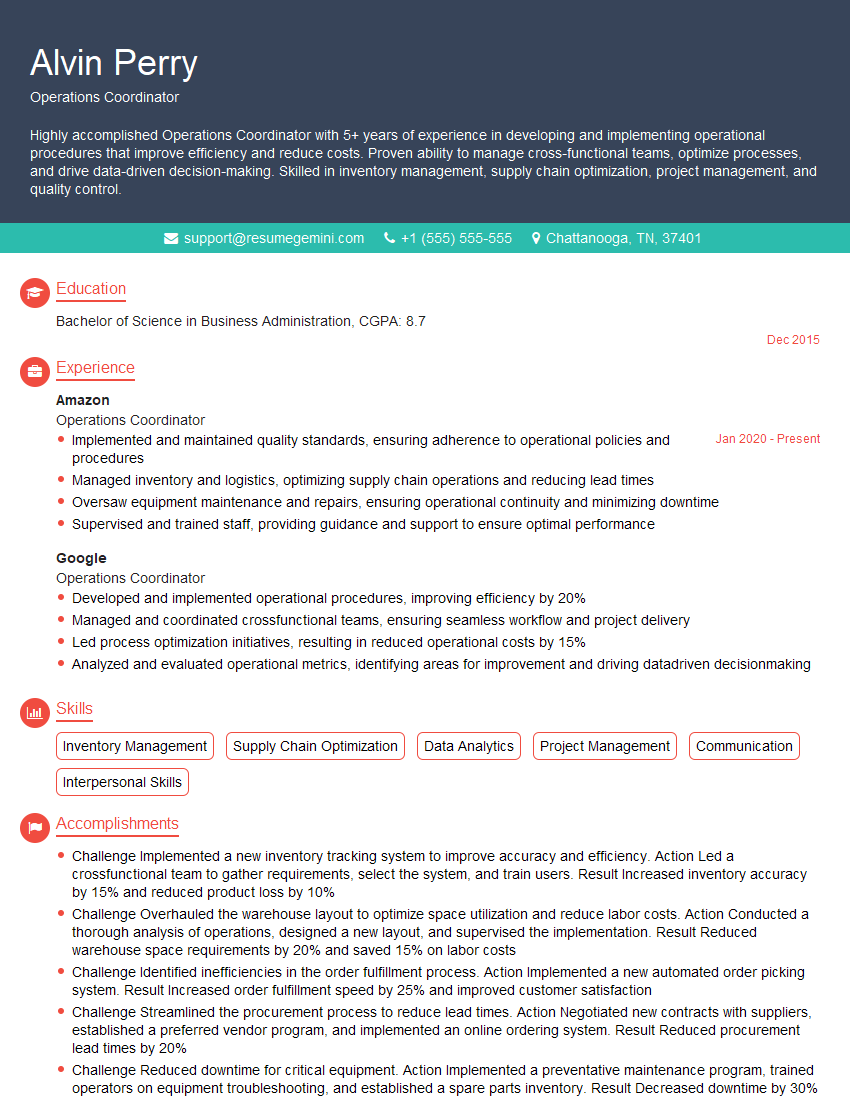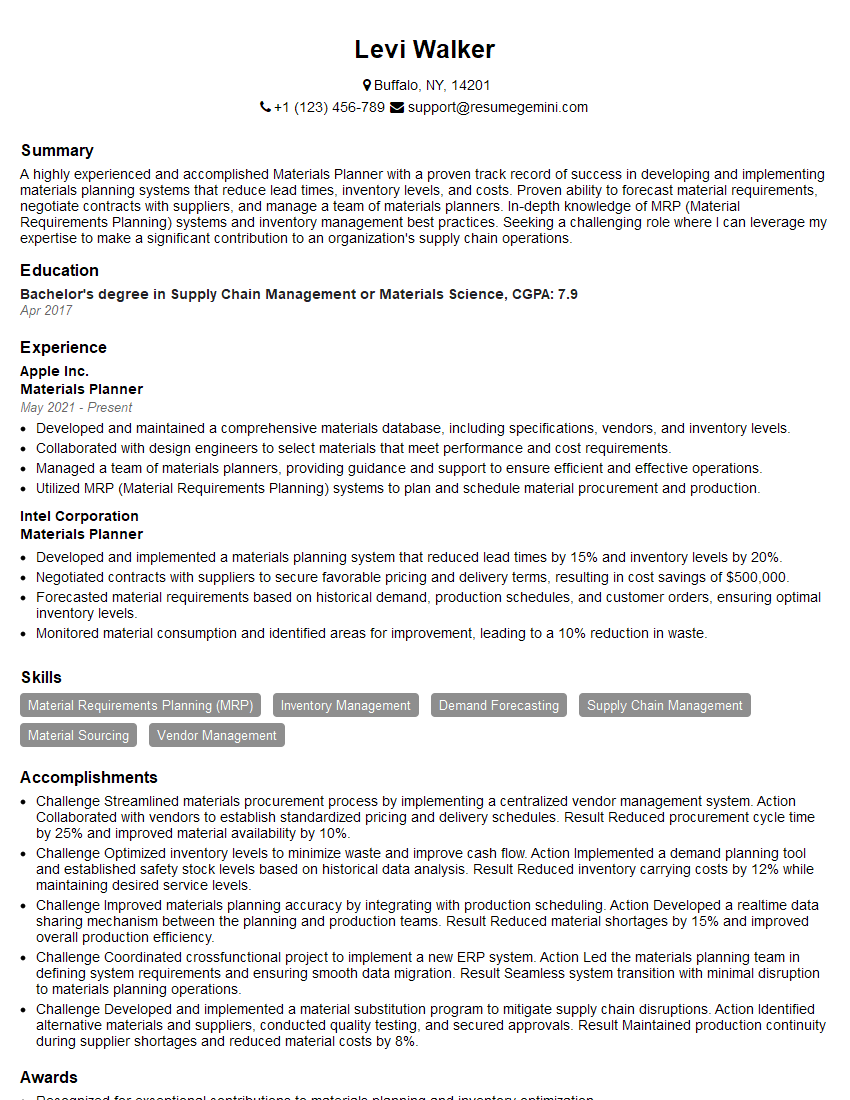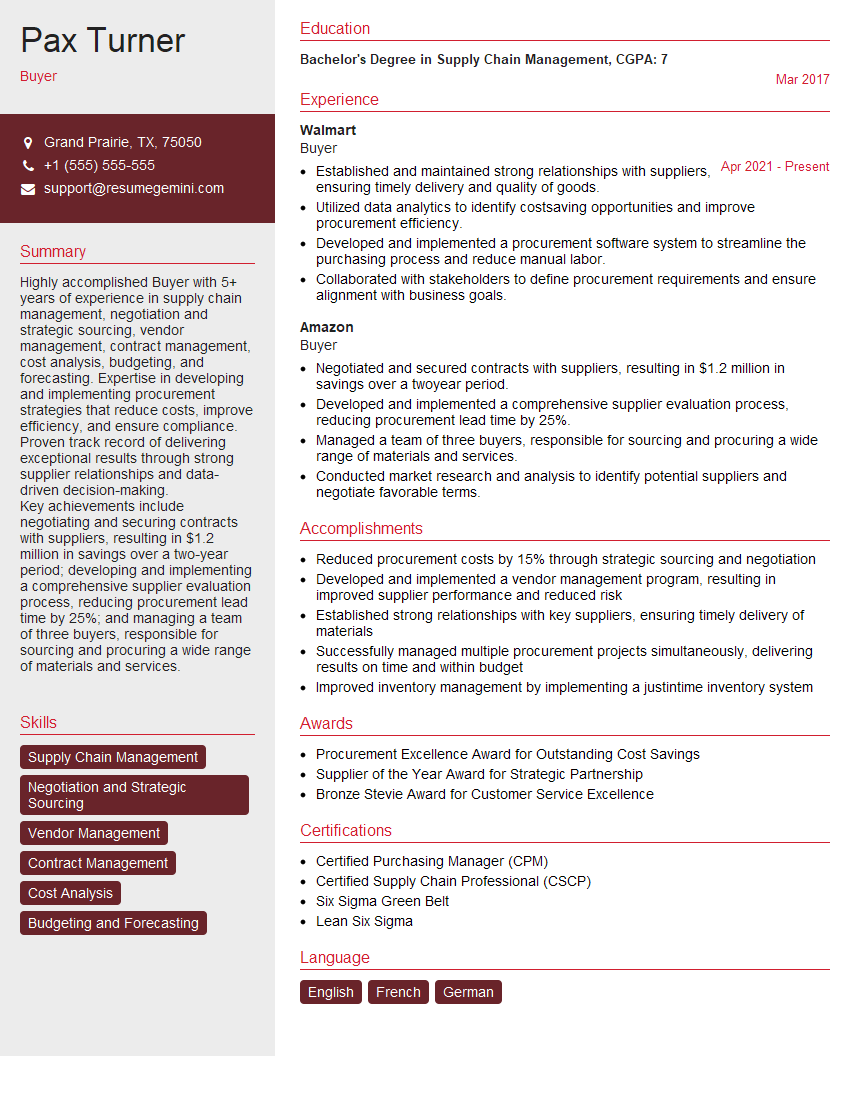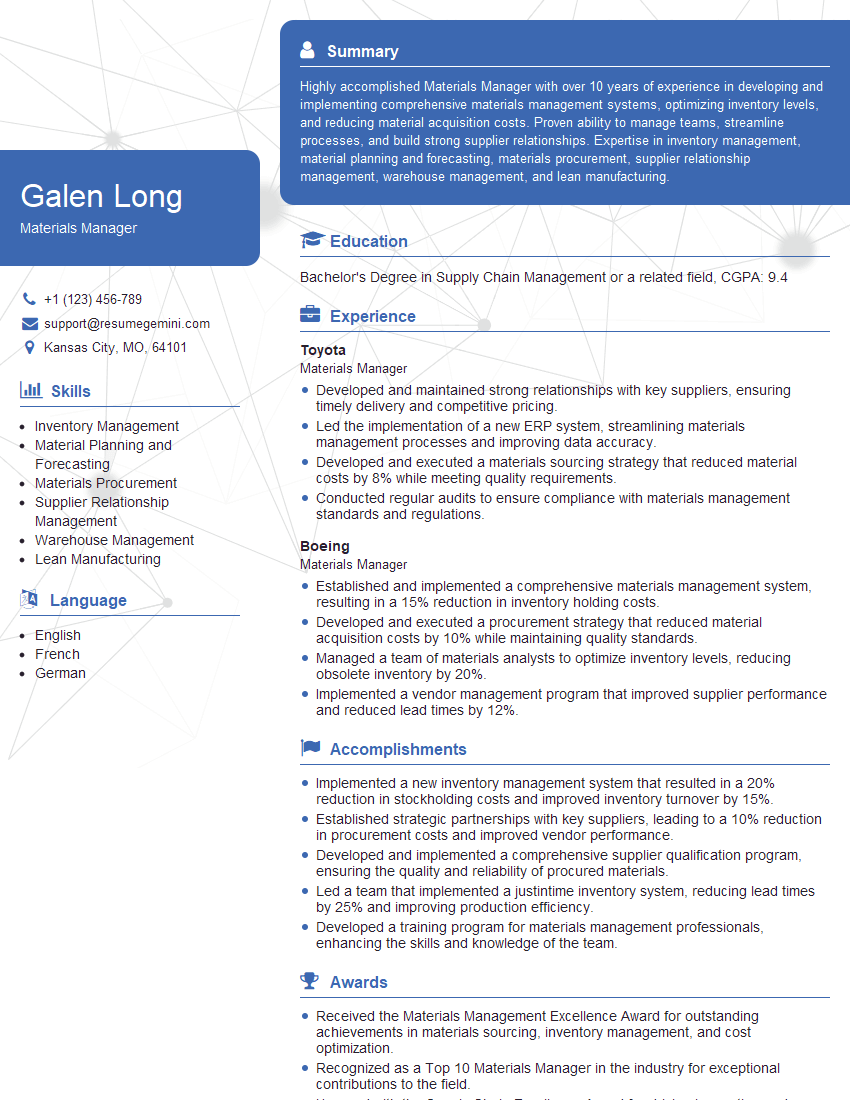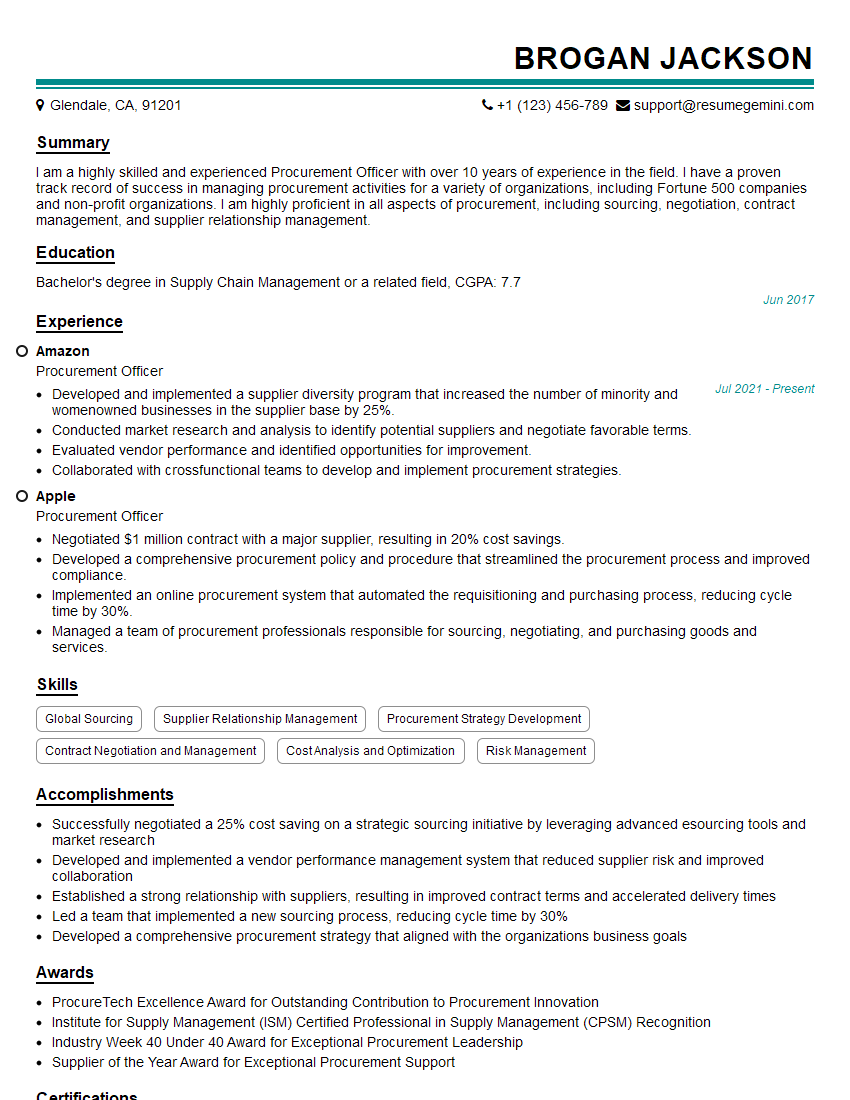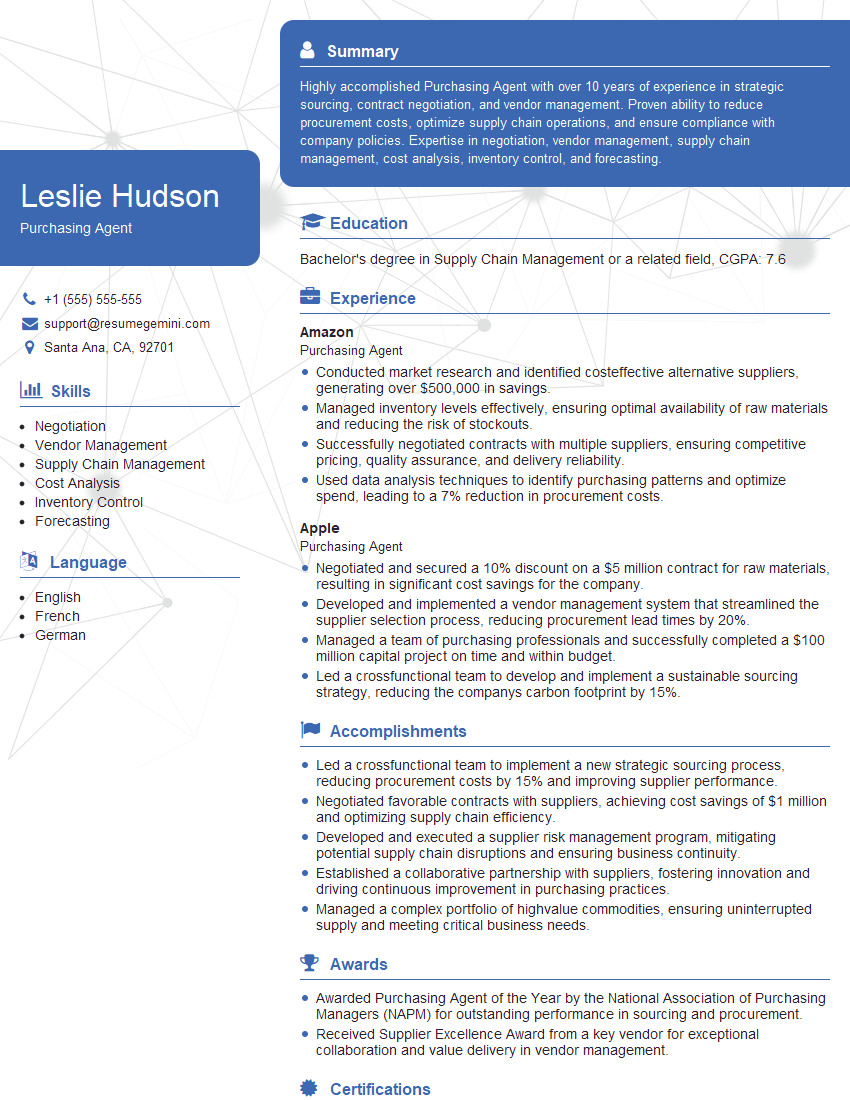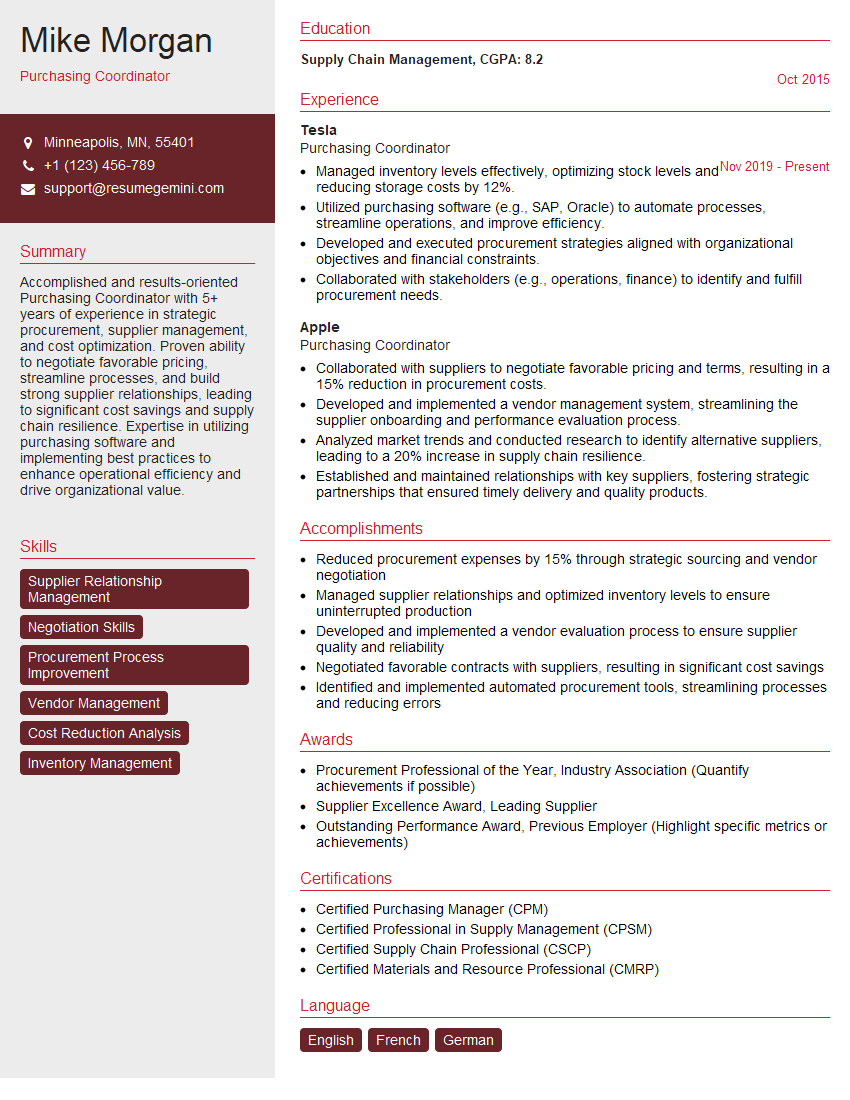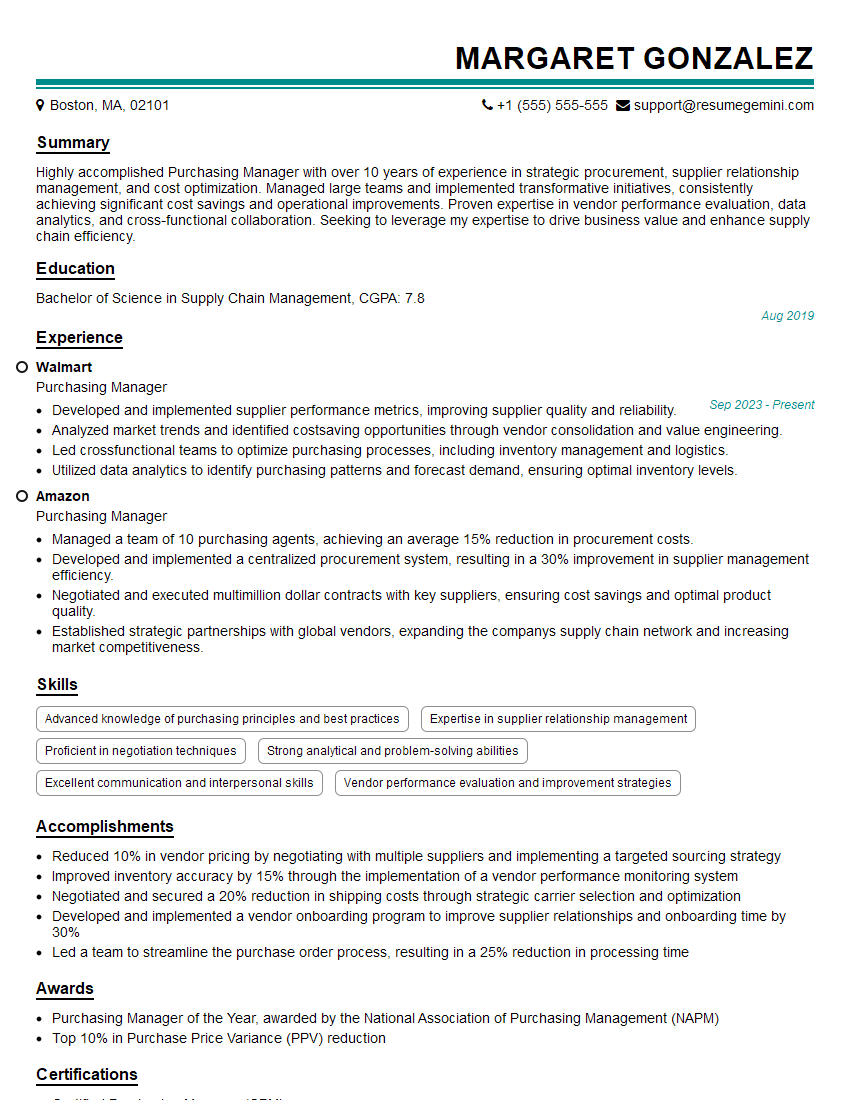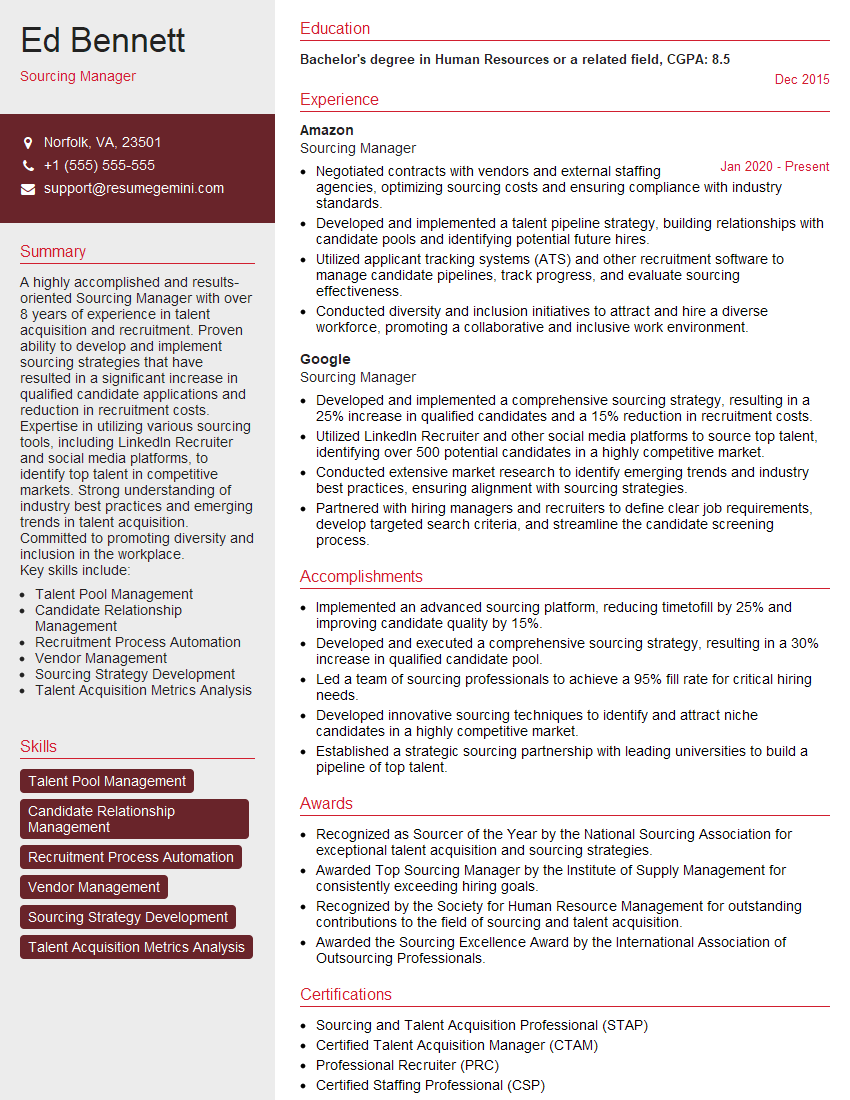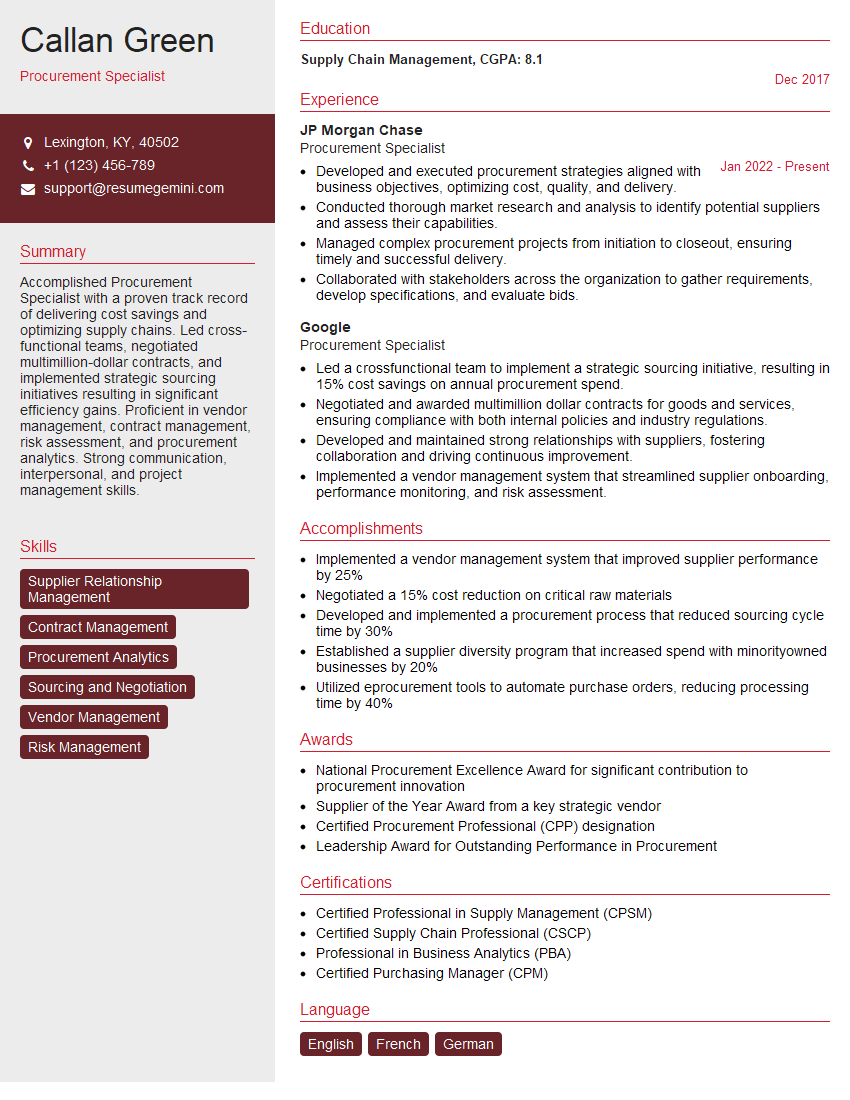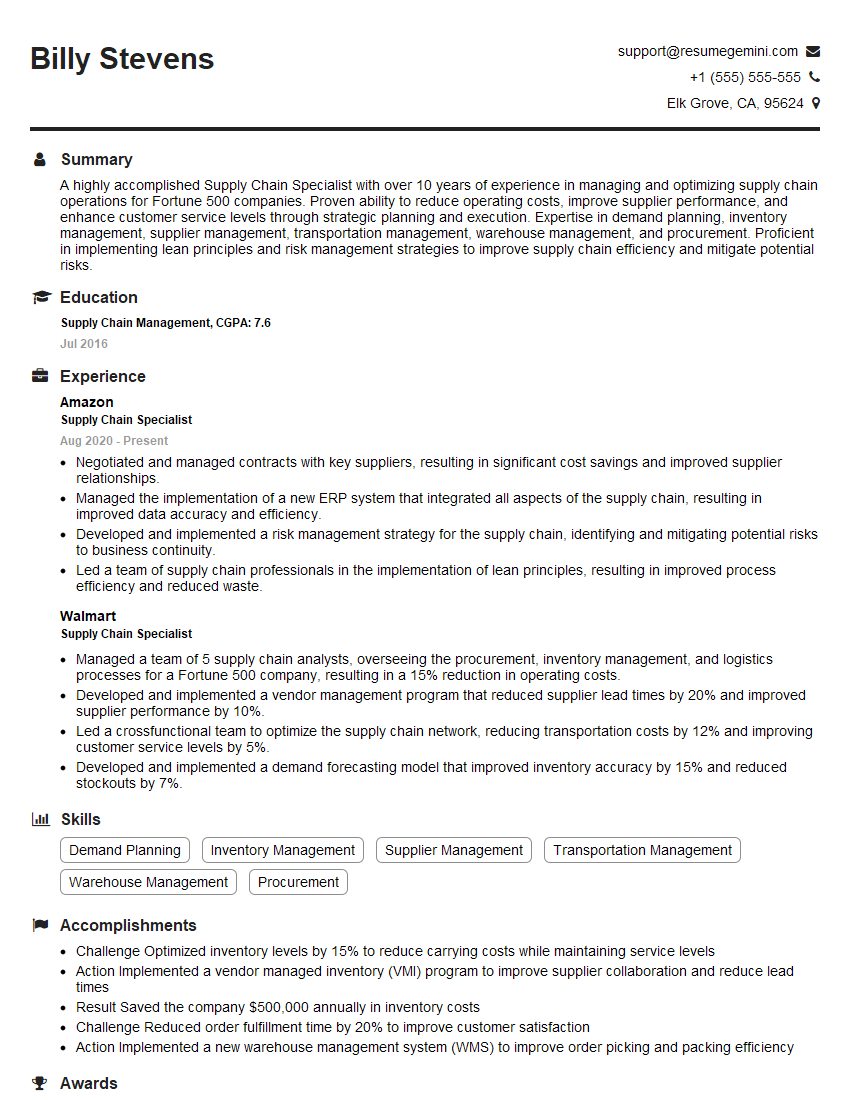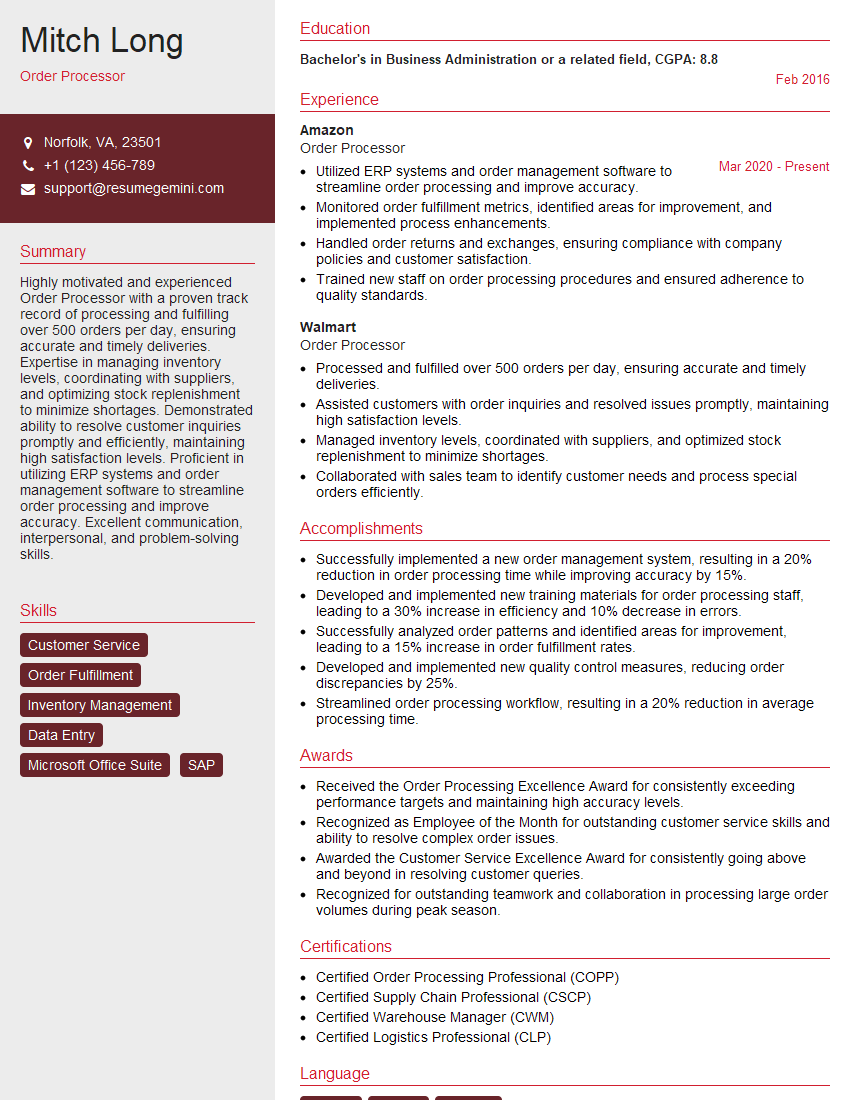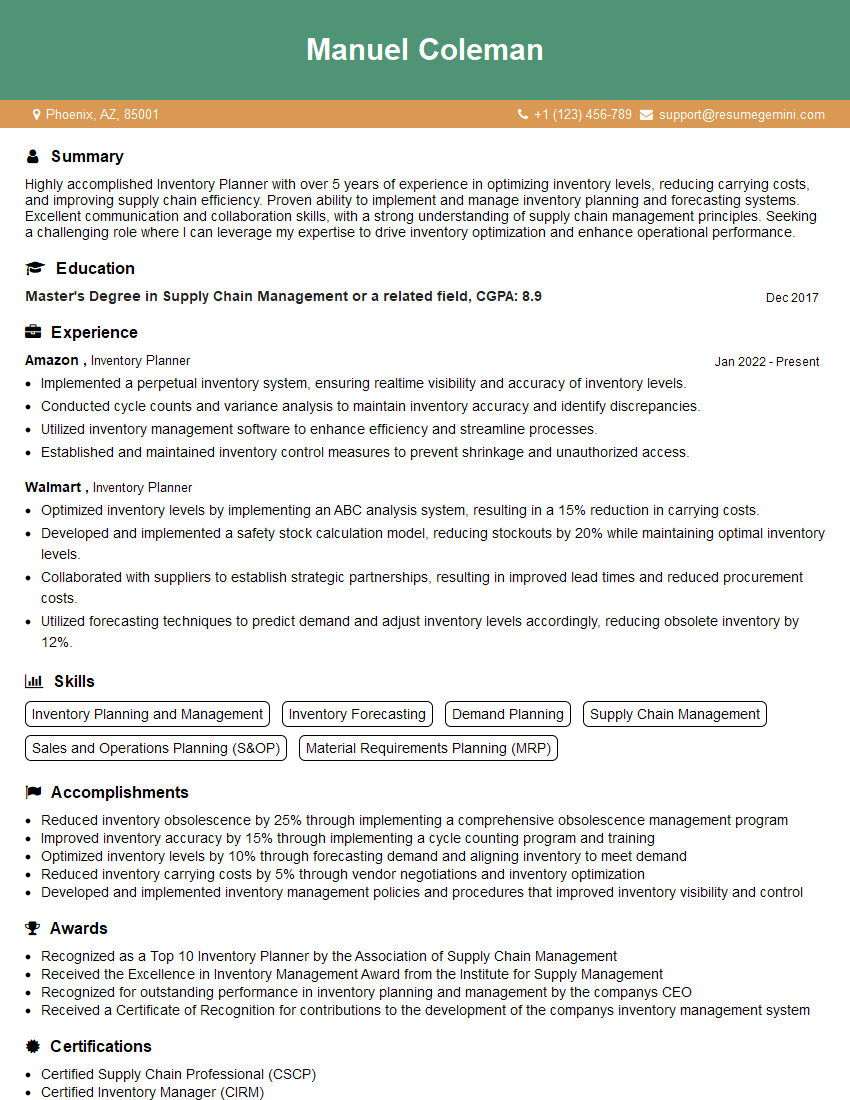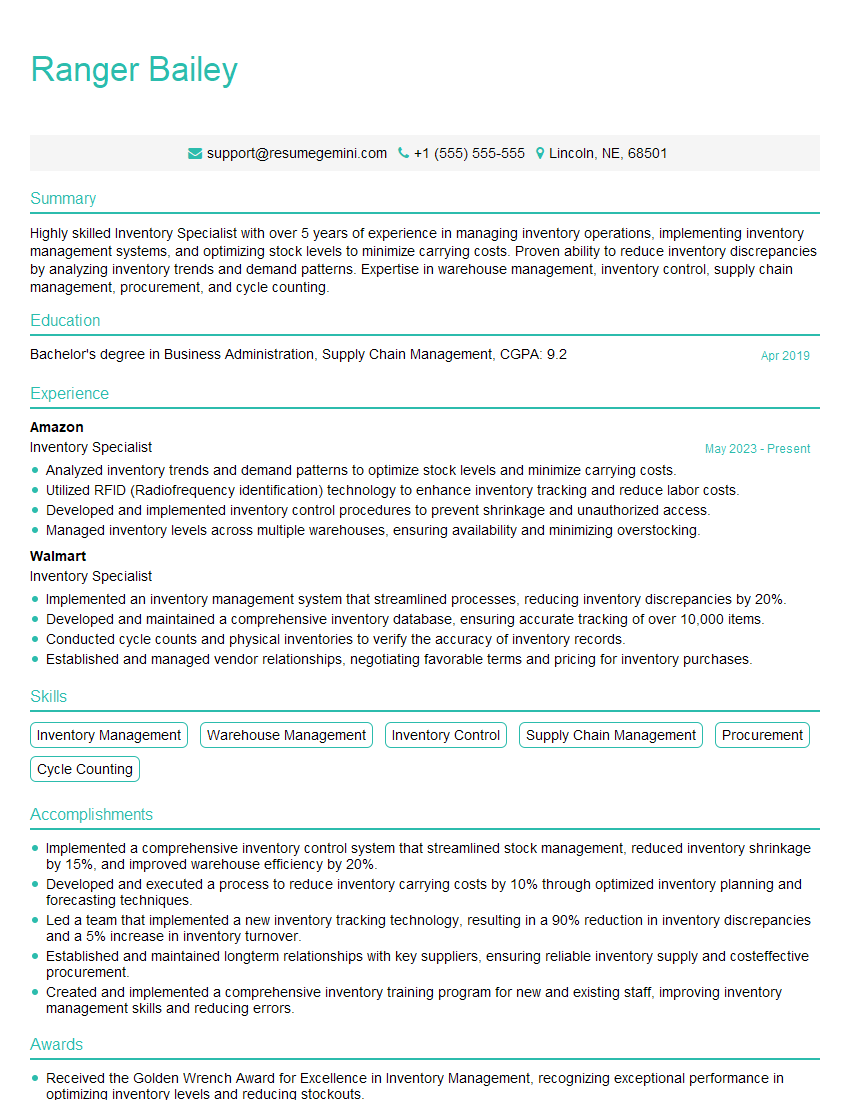Interviews are opportunities to demonstrate your expertise, and this guide is here to help you shine. Explore the essential Materials Ordering interview questions that employers frequently ask, paired with strategies for crafting responses that set you apart from the competition.
Questions Asked in Materials Ordering Interview
Q 1. Explain your experience with different materials ordering systems (e.g., ERP, MRP).
Throughout my career, I’ve extensively used various materials ordering systems, primarily Enterprise Resource Planning (ERP) and Materials Requirements Planning (MRP) software. ERP systems, such as SAP or Oracle, offer a holistic view of the entire business, integrating materials management with other functions like finance and sales. They streamline the ordering process, from requisition to payment, providing real-time visibility into inventory levels and purchase order status. I’ve used them to manage everything from raw materials to finished goods, generating purchase orders, tracking shipments, and managing supplier relationships.
MRP systems, on the other hand, focus specifically on planning and managing materials requirements. They use a bill of materials (BOM) and master production schedule (MPS) to determine the quantity and timing of material needs. I’ve utilized MRP to optimize inventory levels, minimizing holding costs while preventing stockouts. In one project, implementing an MRP system reduced our inventory carrying costs by 15% by precisely forecasting demand and optimizing re-order points.
While both systems are powerful tools, they are often integrated. For instance, I’ve worked in environments where an MRP system feeds into the purchasing module of an ERP system, creating a seamless workflow. The choice between them (or their combined use) depends on the complexity of the manufacturing process and the overall business needs.
Q 2. Describe your process for evaluating supplier performance.
Evaluating supplier performance is crucial for maintaining a reliable supply chain. My process involves a multi-faceted approach, focusing on key performance indicators (KPIs). These KPIs typically include on-time delivery, quality of materials (measured through defect rates and compliance with specifications), price competitiveness, and responsiveness to inquiries and requests.
I use a scoring system to quantitatively assess these factors. For example, a perfect on-time delivery record might earn 10 points, while consistent late deliveries could result in deductions. Similarly, exceeding quality standards earns bonus points, while defects lead to penalties. This system allows for objective comparison between suppliers. I also conduct regular performance reviews with suppliers, providing constructive feedback and addressing any concerns. This open communication helps build strong relationships and improve performance over time. For example, I once identified a consistent delay in delivery from one supplier, which we resolved through collaborative discussion leading to improved logistics planning on their end. This resulted in a 20% improvement in on-time delivery within three months.
Q 3. How do you prioritize orders based on urgency and availability?
Prioritizing orders requires a strategic approach that balances urgency and availability. I use a weighted scoring system, assigning points based on factors like delivery deadline (higher points for shorter deadlines), the criticality of the material to production (essential materials receive higher priority), and the supplier’s lead time (longer lead times demand earlier ordering). For example, a critical component with a short deadline and a long lead time would receive a very high score and be prioritized immediately.
I utilize software features (like those in ERP systems) that allow for filtering and sorting purchase orders based on these weighted scores. This allows me to visually identify and act upon the most urgent and challenging orders. A Kanban board can also be used to visualize order flow and progress, providing a clear overview of the situation and facilitating quick decision-making. This visual approach allows my team and I to swiftly prioritize and manage the most time-sensitive situations.
Q 4. What strategies do you use to negotiate favorable pricing with suppliers?
Negotiating favorable pricing requires preparation and a strategic approach. Before negotiating, I thoroughly research market prices for the materials and compare quotations from multiple suppliers. This ensures that I have a solid understanding of the prevailing market conditions. I then leverage this information during negotiations, presenting data to support my desired price points.
I also focus on building long-term relationships with suppliers. By fostering trust and demonstrating mutual benefit, I can often secure better pricing agreements through volume discounts or other incentives. For instance, in one instance, I negotiated a 10% discount by committing to a higher annual purchase volume, which benefited both the supplier and our company. Finally, I look for opportunities to consolidate orders or streamline processes, as this can lead to efficiencies and reduced costs for the supplier, allowing for better prices for us.
Q 5. Explain your experience managing inventory levels to minimize waste and stockouts.
Managing inventory levels effectively is crucial for minimizing waste and preventing stockouts. I utilize techniques like Economic Order Quantity (EOQ) calculations to determine the optimal order size that balances ordering costs and holding costs. This involves considering factors such as demand, ordering costs, and holding costs. In practice, this often involves using sophisticated inventory management software that integrates with our ERP system to generate automatic re-order points and track inventory levels in real-time.
Regular inventory audits are also crucial to ensure accuracy and identify discrepancies. Furthermore, I implement robust forecasting methods to predict future demand accurately. These methods might involve using historical sales data, market trends, and seasonality information. By combining EOQ analysis, software integration, regular audits, and advanced forecasting, I’ve successfully reduced inventory carrying costs while maintaining adequate stock levels to meet production needs. For example, we implemented a new forecasting model that improved demand prediction accuracy by 15%, leading to a 5% reduction in inventory holding costs.
Q 6. How do you handle unexpected delays in material deliveries?
Unexpected delays in material deliveries require immediate action and proactive communication. My first step is to immediately contact the supplier to understand the reasons for the delay and obtain a revised delivery estimate. I then assess the impact of the delay on our production schedule. This may involve checking for alternative sources of the material, potentially at a higher cost. If an alternative is not feasible, we may need to prioritize other tasks or adjust our production plan to mitigate the disruption.
I also actively communicate the delay to relevant stakeholders, keeping them informed of the situation and any potential consequences. Transparency is essential to maintaining trust and preventing unnecessary panic. For example, once we faced a critical delay in a key component. By immediately engaging with the supplier and finding an alternative (albeit more expensive) source, we managed to minimize the disruption to our production, limiting the overall cost impact significantly.
Q 7. Describe your experience with different types of purchase orders (e.g., blanket orders, standard orders).
I have experience managing various types of purchase orders. Standard purchase orders are used for one-time purchases of specific quantities of materials. They are simple and straightforward but lack the flexibility for ongoing supply arrangements. Blanket purchase orders, on the other hand, are contracts for a specific period that outline terms for future purchases. This allows for better price negotiation and streamlined ordering.
I also use scheduled purchase orders where we order regularly at predetermined intervals (weekly, monthly, etc). This is useful for commonly used materials with predictable demand. Finally, I have experience with framework agreements, which are more strategic agreements outlining broader conditions and purchasing terms, often used for complex projects where numerous purchase orders are expected over time. The choice of purchase order type depends on the nature of the relationship with the supplier, the demand pattern of the material, and the desired level of certainty and flexibility in the supply arrangement.
Q 8. How do you ensure compliance with company purchasing policies and procedures?
Ensuring compliance with company purchasing policies and procedures is paramount for maintaining ethical practices, avoiding legal issues, and ensuring cost-effectiveness. My approach involves a multi-faceted strategy focusing on understanding, implementation, and continuous monitoring.
- Thorough Understanding: I begin by meticulously reviewing all relevant purchasing policies and procedures. This includes understanding guidelines on vendor selection, contract negotiation, approval workflows, and expense reporting.
- Strict Adherence: During the materials ordering process, I rigorously follow all established protocols. This means obtaining necessary approvals at each stage, using designated procurement systems, and documenting all transactions comprehensively. For instance, if a purchase exceeds a certain threshold, I ensure it goes through the appropriate levels of management approval before proceeding.
- Regular Audits and Training: I believe in proactive compliance. I participate in regular internal audits to identify any deviations from established procedures and actively seek opportunities for improvement. I also actively participate in any company training programs that update or clarify purchasing policies and procedures.
- Documentation and Traceability: Maintaining detailed records of all transactions, including purchase orders, invoices, and delivery receipts, is crucial for ensuring transparency and demonstrating compliance. This detailed record-keeping also helps in tracking down discrepancies or resolving disputes later.
For example, in my previous role, I identified a loophole in our travel reimbursement policy that was inadvertently leading to non-compliance. I reported this finding, and we were able to implement a change that clarified the procedures and prevented further issues.
Q 9. Explain your experience with materials requirement planning (MRP).
Materials Requirement Planning (MRP) is a production planning and inventory control system used to determine the materials needed for production, ensuring that the right quantities are available at the right time. My experience with MRP involves utilizing software systems to manage inventory levels, forecast demand, and schedule production based on customer orders and sales forecasts.
- Software Proficiency: I’m proficient in using various MRP software packages, including [mention specific software used, e.g., SAP, Oracle, etc.]. I understand how to input and interpret data, generate reports, and use the system’s analytical tools to optimize inventory levels and production schedules. For example, I can use MRP to create a bill of materials (BOM) for a specific product, which details all the necessary components and their quantities.
- Demand Forecasting: I’ve successfully leveraged MRP systems to forecast material demand, considering factors like seasonal trends, historical data, and sales projections. This helps to avoid stockouts while minimizing excess inventory.
- Inventory Optimization: Using MRP, I’ve implemented strategies to optimize inventory levels by minimizing holding costs while ensuring sufficient stock to meet production needs. This involves carefully balancing carrying costs and the potential costs of stockouts.
- Problem Solving: I utilize MRP to identify and resolve potential material shortages or overstocking situations. For instance, if MRP indicates a potential shortage of a critical component, I can proactively adjust production schedules or place expedited orders to prevent delays.
In a previous project, using MRP analysis, I identified a recurring pattern of overstocking in a particular raw material. By analyzing sales trends and implementing a revised ordering schedule, I was able to reduce excess inventory by 15%, significantly reducing storage costs.
Q 10. How do you identify and mitigate risks associated with materials ordering?
Identifying and mitigating risks associated with materials ordering requires a proactive approach involving risk assessment, vendor selection, and contingency planning.
- Risk Assessment: I systematically assess potential risks throughout the ordering process. This includes evaluating supplier reliability, potential supply chain disruptions (e.g., natural disasters, geopolitical events), quality control issues, and price fluctuations.
- Vendor Selection: I carefully select vendors based on their financial stability, production capacity, quality certifications, and past performance. Diversifying the supply base is crucial to mitigating the impact of potential disruptions from a single supplier. For example, I would avoid relying solely on a single supplier for a critical component.
- Contract Negotiation: Strong contract terms are critical. This includes clearly defining specifications, delivery schedules, payment terms, and quality standards. The contract should also include clauses addressing potential delays, shortages, or quality issues.
- Contingency Planning: Having backup suppliers or alternative materials readily available is essential for handling unexpected disruptions. Regularly reviewing and updating contingency plans is part of responsible risk management. For example, having a secondary vendor for a critical material ensures business continuity in case the primary vendor experiences issues.
- Inventory Management: Maintaining appropriate safety stock levels can mitigate the risk of stockouts due to unexpected delays or demand spikes.
In one instance, I anticipated a potential shortage of a key component due to a geopolitical event. By proactively securing an alternative supply source and negotiating favorable contract terms, we avoided a production shutdown.
Q 11. Describe your experience with vendor relationship management.
Vendor relationship management (VRM) is crucial for ensuring a reliable and cost-effective supply chain. My experience involves building and maintaining strong relationships with key vendors based on trust, open communication, and mutual benefit.
- Strategic Partnerships: I focus on building collaborative relationships with key suppliers, viewing them as partners rather than simply transactional providers. This involves regular communication, performance reviews, and collaborative problem-solving.
- Performance Evaluation: I regularly evaluate vendor performance based on key metrics such as on-time delivery, quality of materials, and responsiveness. This feedback loop helps to identify areas for improvement and strengthen the partnership.
- Negotiation and Contract Management: I am skilled in negotiating favorable contract terms while maintaining positive relationships with vendors. This includes finding a balance between cost savings and ensuring reliable supply.
- Conflict Resolution: When issues arise, I proactively work with vendors to find mutually agreeable solutions. This may involve addressing quality issues, negotiating delivery schedules, or resolving payment disputes.
For example, by building a strong relationship with a key supplier, we were able to negotiate a long-term contract with preferential pricing and guaranteed delivery, resulting in significant cost savings.
Q 12. How do you track and analyze key performance indicators (KPIs) related to materials ordering?
Tracking and analyzing key performance indicators (KPIs) is essential for evaluating the efficiency and effectiveness of the materials ordering process. I utilize a range of KPIs to monitor performance and identify areas for improvement.
- On-Time Delivery Rate: This measures the percentage of orders delivered on or before the scheduled delivery date. A low rate indicates potential supply chain issues.
- Inventory Turnover Rate: This measures how efficiently inventory is managed. A high rate indicates efficient inventory management, while a low rate may suggest overstocking.
- Purchase Order Cycle Time: This measures the time it takes to process a purchase order, from initial request to final delivery. A short cycle time indicates efficient processing.
- Cost per Unit: This tracks the cost of materials per unit produced. Identifying trends in this KPI helps in negotiating better prices with suppliers.
- Supplier Performance: This encompasses metrics such as on-time delivery, quality of materials, and responsiveness. Regularly tracking this helps in identifying and managing underperforming suppliers.
I typically use spreadsheets or specialized software to track these KPIs, creating dashboards and reports to visualize trends and identify areas needing attention. For instance, if the on-time delivery rate drops below a certain threshold, it triggers an investigation into potential causes and corrective actions.
Q 13. How do you handle discrepancies between ordered and received materials?
Discrepancies between ordered and received materials require immediate attention to ensure accuracy and prevent production delays. My approach involves a structured process to identify, document, and resolve these discrepancies.
- Verification and Documentation: Upon receiving materials, I carefully verify the quantity and quality against the purchase order and accompanying documentation. Any discrepancies are immediately documented, including photographs or other evidence.
- Communication with Supplier: I promptly contact the supplier to report the discrepancy, providing detailed information and supporting documentation. I work collaboratively with the supplier to resolve the issue.
- Internal Investigation: If the discrepancy is significant, I initiate an internal investigation to determine its root cause, whether it’s a supplier error, an internal error, or damage during transit.
- Corrective Actions: Based on the investigation, corrective actions are implemented to prevent similar discrepancies in the future. This might involve refining internal processes, improving communication with suppliers, or adjusting inventory controls.
- Documentation and Tracking: I maintain meticulous records of the discrepancy, the corrective actions taken, and the outcome. This provides valuable data for future analysis and process improvement.
For instance, in one case we received a shipment with a significant shortage. After investigation, we discovered an error in the packing slip. We worked with the supplier to resolve the shortage and implemented measures to improve the accuracy of packing slips and verification processes.
Q 14. What is your experience with forecasting demand for materials?
Forecasting demand for materials is crucial for optimizing inventory levels and ensuring a smooth production process. My experience with demand forecasting involves combining quantitative and qualitative methods to create accurate and reliable forecasts.
- Historical Data Analysis: I use historical data on material consumption, sales figures, and production schedules to identify trends and seasonal patterns. This forms the basis of my forecasting models.
- Statistical Forecasting Techniques: I employ various statistical methods, such as moving averages, exponential smoothing, and regression analysis, to project future demand. The choice of method depends on the characteristics of the data and the forecasting horizon.
- Qualitative Factors: I consider qualitative factors, such as market trends, new product launches, economic conditions, and industry forecasts, to refine my quantitative forecasts. These qualitative factors can significantly impact demand.
- Collaboration and Feedback: I collaborate closely with sales, marketing, and production teams to gather information and incorporate their insights into the forecasting process. Regularly reviewing and updating forecasts based on feedback ensures accuracy.
- Software Tools: I utilize specialized forecasting software to streamline the process, facilitating data analysis and model building.
For example, when forecasting demand for a seasonal product, I combined historical sales data with market research to accurately predict demand peaks and troughs. This allowed us to optimize inventory levels, reducing storage costs and preventing stockouts.
Q 15. How do you ensure the quality of materials received?
Ensuring the quality of received materials is paramount. It’s a multi-step process that begins even before the order is placed. We start by rigorously vetting suppliers, verifying certifications (like ISO 9001 for quality management), and conducting audits – both on-site and through document reviews – to assess their capabilities. This includes examining their quality control procedures and traceability systems.
Once the order is received, a thorough inspection is conducted. This may involve visual checks, dimensional measurements using calibrated tools, and sometimes, destructive testing depending on the material’s criticality. For instance, if we’re ordering high-strength steel for a critical component, we’d perform tensile strength testing to confirm it meets specifications. Any discrepancies are documented, and we initiate a non-conformance report with the supplier to address the issue and prevent recurrence.
Sampling methods are crucial. We don’t inspect every single item; statistical sampling plans (like AQL – Acceptable Quality Limit) help determine the appropriate sample size for inspection. This ensures efficiency while maintaining a high level of confidence in the overall quality.
Finally, we maintain a robust system for tracking and analyzing quality data. This allows us to identify trends, pinpoint potential problems early on, and continuously improve our quality assurance processes.
Career Expert Tips:
- Ace those interviews! Prepare effectively by reviewing the Top 50 Most Common Interview Questions on ResumeGemini.
- Navigate your job search with confidence! Explore a wide range of Career Tips on ResumeGemini. Learn about common challenges and recommendations to overcome them.
- Craft the perfect resume! Master the Art of Resume Writing with ResumeGemini’s guide. Showcase your unique qualifications and achievements effectively.
- Don’t miss out on holiday savings! Build your dream resume with ResumeGemini’s ATS optimized templates.
Q 16. Describe your experience with different payment terms and their impact on cash flow.
Payment terms significantly impact cash flow. I’ve worked extensively with various terms, including Net 30 (payment due in 30 days), Net 60, and even consignment arrangements. Net 30 offers a good balance; it provides the supplier with reasonable payment time, and it maintains healthy cash flow for our organization. Net 60 extends this payment window, improving cash flow in the short term but increasing the risk of late payment penalties and straining the supplier relationship if not managed carefully.
Consignment arrangements, where payment is only made upon consumption of the materials, offer excellent cash flow management but typically require a higher degree of trust and a robust inventory management system. We’ve used this successfully for high-volume, slow-moving items where holding costs outweigh the risk.
Understanding the implications of different payment terms is critical. For example, negotiating favorable payment terms with suppliers can free up capital for other critical business functions or allow for taking advantage of early payment discounts, which can offset the cost of financing.
Q 17. Explain your experience with international purchasing and logistics.
My experience with international purchasing and logistics is extensive. It involves navigating complexities like international trade regulations (e.g., tariffs, duties, incoterms), currency fluctuations, and longer lead times. I’ve managed sourcing from various countries, including China, India, and Mexico. This requires a strong understanding of incoterms (Incoterms Rules) like FOB (Free on Board) and CIF (Cost, Insurance, and Freight) to clearly define responsibilities between the buyer and the seller for shipping and insurance.
Logistics is a key component. I work closely with freight forwarders to ensure timely delivery and handle customs clearance. We also utilize tracking systems to monitor shipments in real-time, mitigating potential delays. Choosing the right mode of transportation – sea freight, air freight, or even rail – is critical, considering cost, speed, and the nature of the materials.
Managing risk is crucial. Political instability, natural disasters, and unforeseen logistical bottlenecks can all impact delivery. We use strategies such as diversifying our supply base geographically and building buffer stock to mitigate these risks.
Q 18. How do you manage multiple competing priorities in materials ordering?
Managing competing priorities in materials ordering requires a systematic approach. I utilize prioritization matrices, such as a MoSCoW method (Must have, Should have, Could have, Won’t have), to rank orders based on urgency and importance. This clarifies which orders need immediate attention and which can be slightly delayed. We use a project management software to track all orders and their statuses.
Effective communication is essential. I keep all stakeholders (engineering, production, finance) informed of order status, potential delays, and any necessary trade-offs. Transparency prevents misunderstandings and allows for collaborative decision-making.
A strong understanding of the production schedule is critical. Prioritizing orders aligned with the production plan ensures that materials arrive when needed, minimizing disruptions. Contingency planning for potential delays and material shortages is vital; this may involve sourcing alternative suppliers or materials.
Q 19. Describe your experience with using various software for materials ordering.
I have extensive experience using various software for materials ordering, including ERP (Enterprise Resource Planning) systems like SAP and Oracle, and specialized procurement platforms. These systems streamline the entire process, from purchase requisition to invoice processing. ERP systems, for example, integrate with inventory management, allowing for automated reordering based on predefined thresholds. This minimizes stockouts and reduces manual intervention.
Specialized procurement platforms often offer features such as supplier portals, electronic catalogs, and real-time tracking. This fosters collaboration with suppliers and improves transparency. I’m also proficient in using spreadsheet software like Excel for tracking and analyzing data, particularly for smaller scale projects or ad-hoc analysis.
My software proficiency ensures efficient management of large volumes of data, accurate tracking of orders, and effective communication with suppliers. The choice of software depends on the scale and complexity of operations.
Q 20. How do you stay up-to-date on industry best practices in materials ordering?
Staying updated on industry best practices is a continuous process. I actively participate in professional organizations like ISM (Institute for Supply Management), attend industry conferences and webinars, and read industry publications. This keeps me informed about emerging trends, innovative technologies, and best practices in supply chain management. Participating in online forums and networking with other professionals in the field also provides valuable insights.
Benchmarking against other organizations is helpful to identify areas for improvement in our own processes. Regularly reviewing our own metrics – such as on-time delivery, lead times, and supplier performance – allows us to identify areas needing attention and adjust our strategies accordingly.
Continuous learning is crucial in this dynamic field; staying current ensures that we optimize our processes and remain competitive.
Q 21. How do you handle supplier lead time variations?
Supplier lead time variations are a common challenge. To handle them, we employ several strategies. First, we build strong relationships with suppliers to ensure open communication about potential delays. This allows us to proactively adjust our plans.
We utilize robust forecasting techniques, analyzing historical data and incorporating market trends to predict demand and adjust order quantities and timing. We also maintain safety stock levels for critical materials to buffer against unforeseen delays.
Diversifying our supplier base is crucial. This reduces our reliance on a single supplier and provides options if one experiences delays. Finally, we continuously monitor supplier performance and adjust our sourcing strategies accordingly. If a supplier consistently fails to meet lead times, we may consider finding an alternative supplier.
Q 22. Explain your experience with resolving supplier issues.
Resolving supplier issues is a critical aspect of materials ordering, requiring proactive communication, problem-solving, and a commitment to finding mutually beneficial solutions. My approach involves a structured process: First, I clearly define the problem, gathering all relevant data such as purchase orders, delivery notes, and communication logs. Then, I directly contact the supplier, clearly articulating the issue and outlining the impact on our operations. I favor collaborative problem-solving, exploring potential solutions such as expedited shipping, replacements, or price adjustments. Documentation is key; I maintain detailed records of all communication and agreed-upon resolutions. For example, once a supplier delivered the wrong grade of steel, delaying a crucial project. I immediately contacted them, providing proof of the order discrepancy. We collaboratively agreed on expedited delivery of the correct material, and they offered a credit for the inconvenience. Finally, I analyze the root cause of the issue to prevent recurrence, whether through improved communication protocols or selecting more reliable suppliers.
Q 23. How do you handle returns or damaged materials?
Handling returns or damaged materials requires a systematic approach that prioritizes efficiency and minimizing losses. First, I verify the damage or discrepancy, using clear documentation such as photographs and delivery notes. Then, depending on the supplier’s return policy, I initiate the return process, ensuring all necessary paperwork is completed correctly. This includes clearly stating the reason for the return, and requesting a replacement or credit. I meticulously track the return process, monitoring its progress until resolution. For example, if a batch of components arrives damaged, I immediately document the damage with photos and contact the supplier. Once authorization is received, I return the damaged goods and follow up to ensure the replacement components are shipped and arrive in good condition. Proactive communication with both the supplier and internal stakeholders (like the warehouse team or the project manager) is essential to ensure a smooth process.
Q 24. What are your strategies for improving efficiency in the materials ordering process?
Improving efficiency in materials ordering involves optimizing every stage of the process. My strategies focus on three key areas: Automation: Implementing automated ordering systems reduces manual data entry and minimizes errors. This includes using electronic purchase orders and automated inventory management systems. For example, integrating our ordering system with our ERP (Enterprise Resource Planning) system has significantly streamlined order processing. Process Optimization: Regularly reviewing our processes and identifying bottlenecks is crucial. This involves mapping the current process, analyzing each step for efficiency, and identifying areas for improvement, such as streamlining approvals or consolidating orders. Supplier Relationship Management: Establishing strong relationships with reliable suppliers reduces lead times and improves communication. This involves regularly reviewing supplier performance and collaborating on ways to optimize the supply chain. For instance, negotiating better delivery schedules with key suppliers has resulted in significant improvements in project timelines.
Q 25. Describe your experience with implementing new materials ordering systems or processes.
I have extensive experience implementing new materials ordering systems and processes. This typically involves a phased approach: Planning & Analysis: First, we thoroughly analyze the current system, identifying its limitations and defining the requirements for the new system. This includes stakeholder consultation to ensure buy-in and gather their requirements. Selection & Implementation: Next, we select a suitable system, considering factors such as cost, functionality, and scalability. The implementation phase includes training staff, migrating data, and testing the new system. Monitoring & Optimization: After launch, we closely monitor the system’s performance, addressing any issues and making necessary adjustments. For example, I led the implementation of a new cloud-based materials ordering system, which replaced our outdated, manual system. This involved extensive training for the team, data migration, and rigorous testing. The result was a 30% reduction in order processing time and a significant decrease in errors.
Q 26. How do you contribute to cost reduction in materials ordering?
Cost reduction in materials ordering is a continuous effort, and I employ several strategies to achieve this. Negotiation: Negotiating favorable pricing with suppliers is crucial. This involves leveraging our purchasing power, exploring volume discounts, and negotiating extended payment terms. Supplier Selection: Choosing reliable suppliers with competitive pricing is essential. This involves evaluating suppliers based on factors such as price, quality, delivery reliability, and financial stability. Inventory Management: Optimizing inventory levels prevents stockouts and reduces storage costs. This involves implementing inventory management techniques such as Just-in-Time (JIT) delivery. For example, by negotiating better pricing with our primary steel supplier and implementing a JIT delivery system, we reduced our material costs by 15%.
Q 27. Explain your experience with managing a materials budget.
Managing a materials budget requires careful planning, tracking, and analysis. I begin with forecasting material needs based on projected production schedules and historical data. This involves collaborating with various departments, such as production and engineering, to ensure accurate demand forecasting. Then, I develop a budget, allocating funds to different material categories based on the forecasted needs and market prices. Throughout the year, I track actual spending against the budget, identifying any variances and investigating their causes. For example, if we experience a significant increase in material prices, I explore options such as sourcing from alternative suppliers or negotiating new pricing agreements with our current suppliers. Regular reporting and analysis enable proactive adjustments and prevent budget overruns. This also involves identifying cost-saving opportunities, such as bulk purchasing or negotiating better payment terms.
Key Topics to Learn for Materials Ordering Interview
- Supplier Relationship Management (SRM): Understanding the nuances of building and maintaining strong relationships with key suppliers, negotiating contracts, and managing supplier performance.
- Inventory Management Techniques: Applying methods like Just-in-Time (JIT), Economic Order Quantity (EOQ), and Material Requirements Planning (MRP) to optimize inventory levels and minimize costs. Practical application includes analyzing inventory data to identify inefficiencies and propose solutions.
- Demand Forecasting and Planning: Accurately predicting future material needs based on historical data, sales projections, and market trends. This includes understanding forecasting methodologies and their limitations.
- Procurement Processes and Procedures: Mastering the entire procurement cycle, from requisition to receiving and payment, including understanding purchasing policies, compliance regulations, and internal approval workflows.
- Cost Analysis and Control: Analyzing material costs, identifying areas for cost reduction, and implementing strategies to control spending within budget. This also involves understanding different costing methods.
- Material Handling and Logistics: Understanding the efficient movement and storage of materials, including warehouse management, transportation, and delivery scheduling. This involves optimizing logistics to minimize costs and delays.
- Technology in Materials Ordering: Familiarity with Enterprise Resource Planning (ERP) systems and other software used for materials ordering, inventory management, and procurement. This includes understanding data analysis within these systems.
- Risk Management in Procurement: Identifying and mitigating potential risks associated with materials ordering, such as supply chain disruptions, price fluctuations, and quality issues. This includes developing contingency plans.
Next Steps
Mastering materials ordering is crucial for career advancement in procurement, supply chain management, and operations. A strong understanding of these concepts positions you for leadership roles and higher earning potential. To significantly boost your job prospects, crafting an ATS-friendly resume is essential. ResumeGemini is a trusted resource to help you build a professional and impactful resume that highlights your skills and experience effectively. Examples of resumes tailored to Materials Ordering are available to guide you through this process.
Explore more articles
Users Rating of Our Blogs
Share Your Experience
We value your feedback! Please rate our content and share your thoughts (optional).
What Readers Say About Our Blog
Dear Sir/Madam,
Do you want to become a vendor/supplier/service provider of Delta Air Lines, Inc.? We are looking for a reliable, innovative and fair partner for 2025/2026 series tender projects, tasks and contracts. Kindly indicate your interest by requesting a pre-qualification questionnaire. With this information, we will analyze whether you meet the minimum requirements to collaborate with us.
Best regards,
Carey Richardson
V.P. – Corporate Audit and Enterprise Risk Management
Delta Air Lines Inc
Group Procurement & Contracts Center
1030 Delta Boulevard,
Atlanta, GA 30354-1989
United States
+1(470) 982-2456
